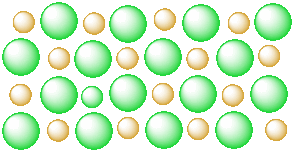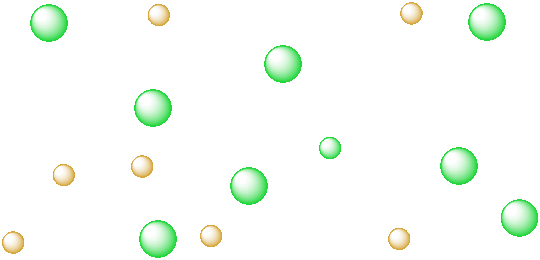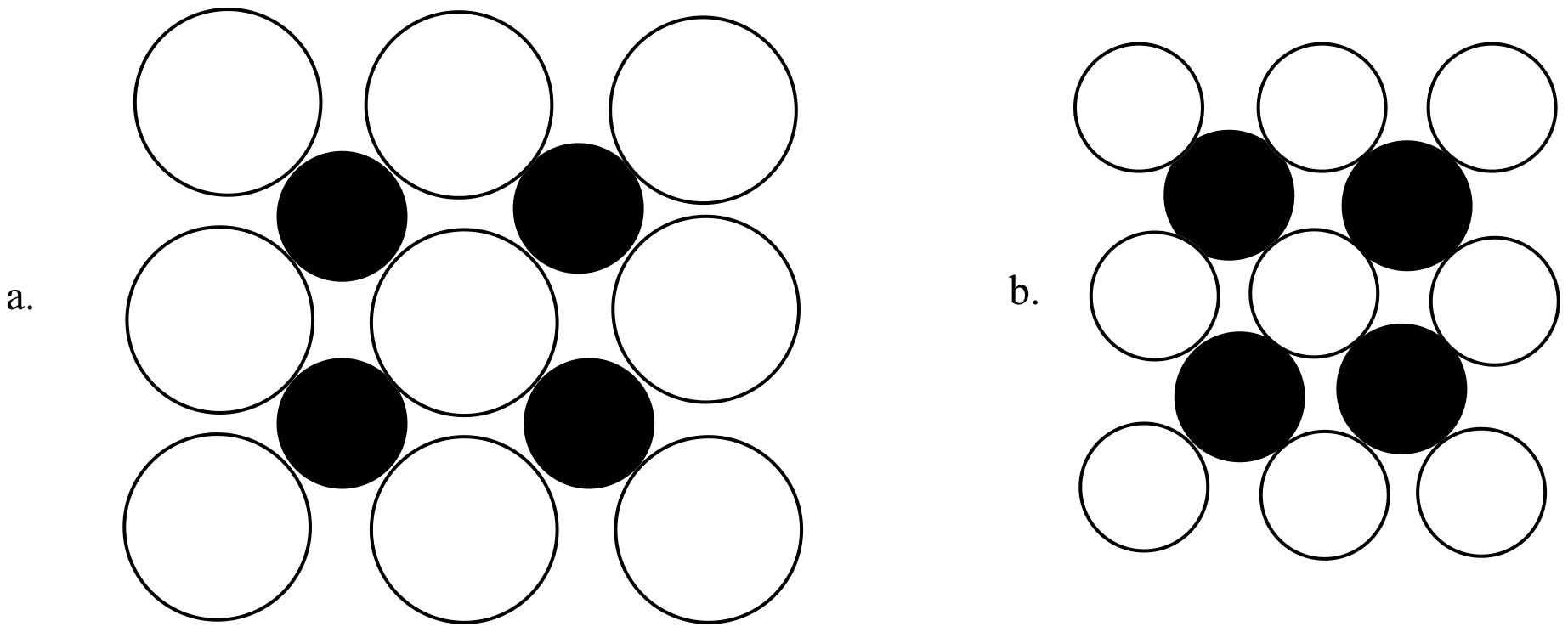Structure & Reactivity in Chemistry
IC. Ionic Compounds
IC3. Physical Properties
The strong electrostatic forces of attraction of a cation
for its surrounding anions, and the strong electrostatic forces of
attraction of an anion for its surrounding cations, keep the compound together.

Figure IC3.1. A salt in the solid state.
The ions are tightly packed together in an ordered arrangement.
Most of the time, we think of ionic
compounds as solids. In the solid state, the ions are very close together.
The forces of
attraction between cations and anions are very high. In the liquid (melted) state, the ions would move around
independently, and would be able to move a little farther apart from each other. In order to accomplish this independent movement, a great deal of
energy would have to be supplied to get over the strong forces of
attraction in the solid state.
It takes a lot of heat to supply enough energy to convert them into liquid.

Figure IC3.2. A salt in the liquid (melted) state.
The ions are still close together but more mobile and less ordered.
In the gas phase, ions would be very far from each other and would
move very freely. They would no longer attract each other very strongly
because of the distances between ions. In order to convert an ionic compound into vapour, an enormous
amount of energy would have to be supplied to overcome the attractions
in the solid or liquid phase. Often, so much energy is supplied that they undergo decomposition into different
compounds rather than boiling.

Figure IC3.3. A salt in the vapor state.
The ions are far apart and randomly arranged.
- Ionic compounds have extremely high boiling points.
The changes of state in ionic compounds are governed by simple
electrostatic forces between the ions. These electrostatic forces are governed by Coulomb's Law, in which
the force of attraction depends on the amount of charge and the distance
between the ions. That means that there are sometimes predictable
variations in the properties of ionic compounds.
For example, among the potassium halides, the melting point is lowest for the
iodide (681oC) and highest for the fluoride(858oC). The reason for that comes
from the distance dependence in Coulomb's law.
Iodide is a bigger ion than bromide, chloride or fluoride. That means the
distance between atoms is greater in potassium iodide than in potassium
fluoride. In other words, the average distance between the positive
potassium nucleus and the negative electrons surrounding the anion is
greater for iodide than for chloride or fluoride. Note that this
average distance really amounts to the distance between the two nuclei.
The greater the distance between ions, the lower the forces of
attraction. The ions in potassium iodide can move around more easily
than the ions in potassium fluoride. Potassium iodide has a lower
melting point than potassium fluoride.
- Compounds containing smaller ions often have higher melting points than
similar compounds that contain larger ions.
Problem IC3.1.
Select the compound that would have the lowest melting
point in each of the following pairs.
a) KCl or LiCl
b) NaF or NaBr c) CaO or BeO d) LiF or
KBr
There is another factor, too: the force of attraction
between ions also depends on the magnitude of the charges involved. The greater the
size of the charge on an ion, the greater the
force of attraction for its counterion.
For example, calcium fluoride, CaF2, has a lower melting point
(1418
oC) than
calcium oxide, CaO (2572
oC).
This difference is probably not due to differences in the distance
between the charges. Fluoride and oxide are almost the same size, and if
anything fluoride is a little smaller. Based on interionic distance
alone, fluoride could have a slightly higher melting point than calcium
oxide.
However, each fluoride has a 1- charge, but the oxide has a 2- charge. As a result of this greater charge, the force of attraction between
an oxide and a calcium ion is stronger than the force of attraction
between a fluoride and a calcium ion. It is more difficult to get the calcium and oxide ions to move away
from each other, and the melting point is higher than for calcium
fluoride.
- Compounds containing
more highly charged ions often have higher melting points than similar
compounds that contain lower charged ions.
Problem IC3.2
Select which of the following compounds would have the lowest melting point. Assume that
the cations and the anions in each structure are all +1 or -1, respectively.

Problem IC3.2
Select the compound that would have the highest melting
point in each of the following pairs.
a) KCl or CaCl2
b) NaF or Na2O
c) CaO or NaF
Problem IC3.4.
The melting point of NaCl is 801°C. Estimate (guess!) the
melting point of the following compounds. (More important than the actual number
you come up with is whether it is larger or smaller than the melting point of
NaCl and by a lot or a little.)
a) KCl
b) NaF
c) Na2O
d) MgS
This site was written by Chris P. Schaller, Ph.D., College of Saint Benedict / Saint John's
University (retired) with contributions from other authors as noted. It is freely
available for educational use.

Structure &
Reactivity in Organic, Biological and Inorganic Chemistry
by Chris Schaller is licensed under a
Creative Commons Attribution-NonCommercial 3.0 Unported License.
Send corrections to cschaller@csbsju.edu
Navigation:
Back to Ionic Compounds Index
Back to Structure & Reactivity Web Materials




